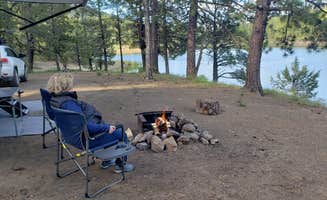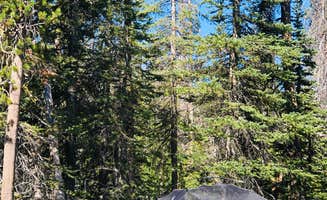Tent campsites near Beatty, Oregon cluster within the Fremont-Winema National Forest at elevations between 4,200-5,000 feet. The region experiences cold winters with significant snowfall that typically restricts access to most forest camps until late spring. Summer temperatures average 75-85°F during daylight hours but can drop below 40°F at night even in July and August.
What to do
Fishing opportunities: Holbrook Reservoir offers productive fishing according to visitors. One camper noted, "The fishing was really good and both of my kids caught their first fish during this trip." Wildlife enthusiasts often spot pelicans, ospreys, and bald eagles hunting at the reservoir.
Creek access: Clear Spring Forest Camp provides direct access to Dairy Creek with "a couple spots to put your tent right next to Dairy Creek" according to one visitor. The camp also features a natural spring "flowing into a small pool" with "tons of flow" that provides clean drinking water.
Wildlife observation: The remote setting attracts diverse wildlife. At Holbrook Reservoir, a camper observed "white pelicans, ospreys, Buffleheads, Double-crested Cormorants, and a Bald Eagle." Beaver activity is common near some campsites, with visitors reporting they "could hear them thumping in the evening."
What campers like
Natural water sources: Campers appreciate access to natural springs and creeks. At Clear Spring Forest Camp, the spring is located "just across the road where it has easy access through a pipe flowing into a small pool" rather than the quarter-mile distance sometimes reported.
Secluded campsites: Corral Creek provides genuine solitude according to visitors. One camper reported, "There was one other trailer there in the campground that I neither saw nor heard anyone the entire time... never heard another person."
Waterfront camping: Multiple camping areas at Holbrook Reservoir offer lakeside sites. A visitor advised, "Don't just stop at the first section like we did, there are sites along the back of the lake too, go past the 1st lot with the bathrooms and follow until you find a site you like."
What you should know
Variable site amenities: Amenities differ significantly between camping areas. At Horseglade Trailhead Campground, campers will find "a very small simple designated camping area with a very clean pit toilet and a few picnic tables but nothing else."
Fire damage: Several forest camps show evidence of past wildfires. At Deadhorse Lake, a camper warned about "the dead forest. That made it kind of uncomfortable in the heat of summer. Brings tarps for shade."
Road conditions: Forest service roads require careful navigation. At Holbrook Reservoir, visitors report "typical forest service type roads requiring you to go fairly slowly and watch out for potholes." Some routes become impassable during wet weather.
Insect activity: Multiple camping areas report significant mosquito populations during summer months. One camper at Holbrook Reservoir noted "Lots of mosquitoes but worth it." Bug repellent is considered essential equipment during peak season.
Tips for camping with families
First-time fishing: Happy Camp provides accessible water features for children. The "site at the far back to the right is far and away the best with its own beach on the river" which offers safer water access for younger children.
Limited facilities: Most tent sites lack basic amenities for families. A camper advised, "If you don't have a trailer with a bathroom, you have to go to another area to use the outhouse." Parents should prepare children for primitive conditions.
Wildlife viewing opportunities: Children often enjoy the abundant wildlife viewing. One visitor to Holbrook Reservoir mentioned, "I loved to watch the pelicans, and the fishing was great," providing natural entertainment for families.
Tips from RVers
Site access limitations: Forest camps typically accommodate only smaller RVs and trailers. A camper at Holbrook Reservoir reported, "We were able to park our 20 foot trailer near the lake," suggesting this represents the upper limit for comfortable accommodation at most sites.
Pack additional shade: Rock Creek Forest Camp and other fire-affected sites provide minimal natural shade. RVers should bring awnings or shade structures during summer months when temperatures frequently exceed 85°F.
Limited turnaround space: Most forest service roads lack designated turnaround areas for larger vehicles. Backing into sites often requires careful maneuvering, with limited space to correct positioning errors once on narrow access roads.



